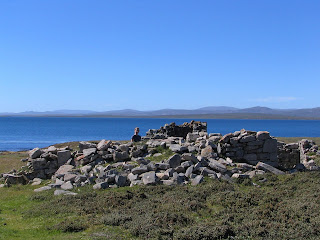I loved the Rookery and would go back in a heartbeat. The weather was amazing which always helps, but the dramatic coastline combined with the hundred, if not thousands, of albatrosses and a large colony of rockhoppers made it, for me, more enjoyable than the Neck. For me, (and for Gemma - my friend who’s a bird observer and whose job is basically to try and stop albatross from getting killed by longliners) seeing the albatross on land and breeding was an amazing experience. I’m so used to seeing them at sea that to see them up close on the ground was just fantastic. The chicks were so big and fluffy and the adults seemed to be so nonplussed by our presence that you could get incredibly close without causing any (apparent) stress. The nests the albatrosses build are really impressive. They’re made from mud and are perfectly round. The chicks are these big balls of grey fluff which stand up straight at squawk at you if you accidentally get too close. They lie top-to-tail with the paren





